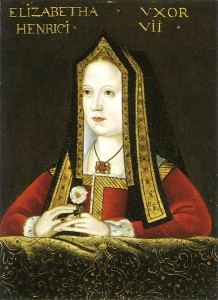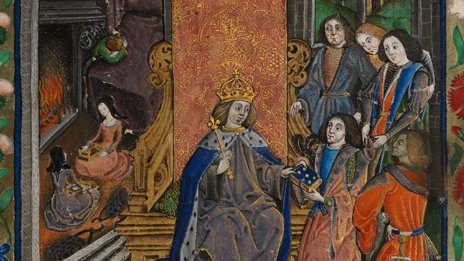
11 February is the date of both the birth and death of Elizabeth of York, consort of King Henry VII. Elizabeth was born on this day in 1466 and she died on this day in 1503.
Elizabeth was the eldest child of King Edward IV and his consort Elizabeth Woodville and was born on 11 February 1466 at Westminster Palace, London. She was baptised in St Stephen’s Chapel in Westminster Abbey, with the Earl of Warwick standing as godfather and her grandmothers, the Duchesses of York and Bedford, standing as godmothers. She was named Elizabeth after her mother and was soon given her own household at Greenwich Palace under the care of Lady Margaret Berners.
Elizabeth’s father, Edward IV, had managed to capture and imprison Henry VI in 1461, dethroning him and taking the crown for himself, starting the royal House of York. However, Edward’s controversial marriage to Elizabeth Woodville caused trouble for Edward when Elizabeth alienated powerful Yorkist supporters, causing them to side with Lancastrians and challenge Edward. The result was that Edward was driven into exile and the throne became Henry VI’s once more in October 1470.
Henry’s reign was short-lived with Edward overthrowing him once again in April 1471. Ex-Yorkists and Lancastrians were defeated in battle, and Henry VI was killed in the Tower. Edward had stamped out his enemies. Unfortunately, tragedy struck the House of York at Easter 1483 when Edward caught a chill on a fishing trip. He died on 9th April, and his thirteen year-old son Edward became Edward V. Edward V was too young to reign in his own right, so his uncle, Richard, Duke of Gloucester, became Protector. To cut a rather long story short, with Edward V and his younger brother, Richard, Duke of York, ‘residing’ in the Tower of London, Richard was crowned King Richard III on 6 July 1483 and the boys disappeared, going down in history as ‘The Princes in the Tower’. It is not clear what happened to them.
Elizabeth of York mourned the loss of her brothers, but her mother decided on revenge, and this is when she decided to approach Lady Margaret Beaufort. Although the two ladies were supposed to be on different sides, Elizabeth being from the House of York and Margaret being a Lancastrian, neither lady was happy with Richard on the throne, and decided that a union between their children could bring about Richard’s downfall. Henry Tudor defeated Richard III on 22nd August 1485 at the Battle of Bosworth Field, becoming King Henry VII, and went on to marry Elizabeth on 18th January 1486. Although the marriage was a political union, uniting the once warring Houses of Lancaster and York, it was happy and successful. Elizabeth and Henry had eight children, although only four of them survived infancy: Arthur, Margaret, Henry and Mary.
On 2nd February 1503, after a long labour, Elizabeth gave birth to her eighth and final child, a little girl called Katherine. Little Katherine died on 10th February and her mother followed her on 11th. It is not known what the Queen died of but it must have been a post-partum infection or complication, like puerperal fever or haemorrhaging. Elizabeth was buried at Westminster Abbey after a lavish funeral. Today, visitors can pay their respects at the magnificent tomb of Henry VII and Elizabeth of York in the Abbey’s Lady Chapel, built by Henry VII.
If you want to know more about Elizabeth of York then I would recommend getting hold of a copy of Amy Licence’s biography of her, Elizabeth of York: The Forgotten Queen of England, which is available from Amazon.com, Amazon.co.uk or your usual bookstore. You can read a review of it on our Tudor Book Reviews site – click here.
Trivia: During Elizabeth of York’s childhood, she was betrothed to George Neville, son of John Neville, Marquess Montagu, and then to Charles the Dauphin, son of Louis XI.
This image is from the Vaux Passional and is thought to depict Henry VII and his children mourning the loss of Elizabeth. The figure weeping on the bed is believed to be Prince Henry (the future Henry VIII) and the girls in front of the bed are believed to be Princess Margaret and Princess Mary.

Notes and Sources
- Ridgway, Claire (2012) On This Day in Tudor History, MadeGlobal Publishing.
- Licence, Amy (2013) Elizabeth of York: The Forgotten Queen of England, Amberley Publishing
- Horrox, Rosemary (2004) Elizabeth (1466–1503), Oxford Dictionary of National Biography, Oxford University Press
- The Vaux Passional, the National Library of Wales.